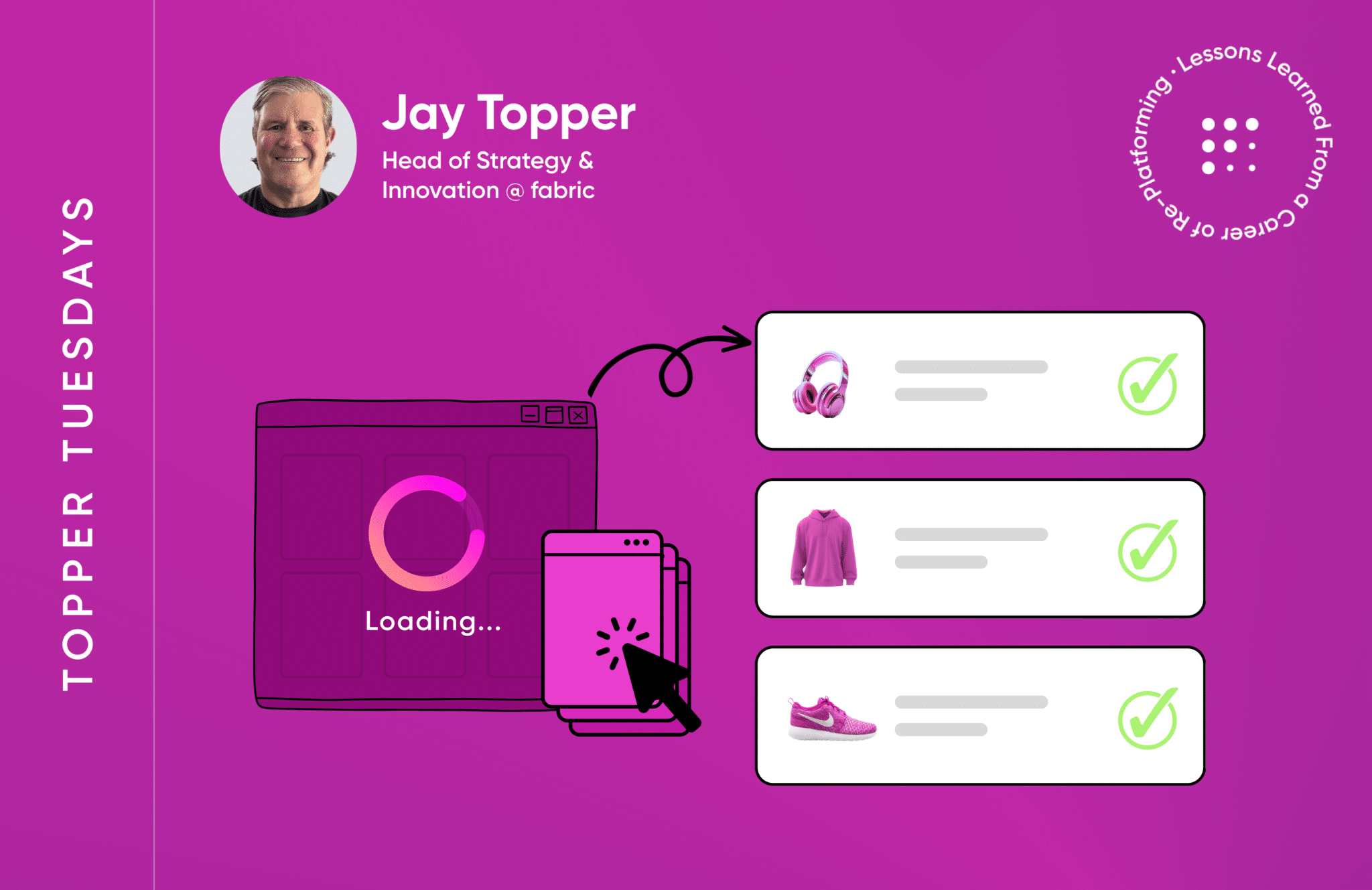Replatforming Implementation: Time To Execute!

I love executing because there are two thrills in a major replatform of any kind.
The first is the day you sign the contracts with the partner and platform provider. Sometimes the process to get to this point takes almost as long as the implementation itself. But there are SO MANY UNKNOWNS when you start a process. This upfront effort I’ve been writing about for two months de-risks these implementations. In addition, your partner and platform are celebrating a win because your signature represents a huge milestone for each of them.
The second biggest thrill is when you go fully live with “real” traffic. But this thrill is more of a journey versus a destination. It’s a multi-pronged program with seemingly countless tasks, documentation, coding, testing and testing more. It often involved daily releases and fixes, and ultimately slowly building traffic until some final point where the new platform is fully live!
10 tips to get the thrill of go-live
A successful replatforming is exhilarating! I want to help you experience that feeling.
I’ve learned a lot performing more implementations, upgrades and replatforms than I can easily count – and I tried. It’s somewhere over 100 in total.
I love tying solution design and architecture to business problems and outcomes. But, to get there, it comes down to execution, which I love even more! So, here are my top 10 tips and tricks for successful implementations–the bigger the magnitude, the more myopically I embrace these principles!
Tip #1: Meet in person periodically as an entire team.
Look, it’s a hybrid world. Or, even a remote one. But NOTHING replaces three companies coming together for the first time with so much on the line.
- Reiterate the process that brought everyone forward to this point.
- Introduce everyone (again!) and treat it almost like a first day.
- Map out roles and responsibilities, and be willing to pivot to people’s strengths. A simple RACI now at least starts the project in a defined place, even if it changes over time – and it will!
- Listen to people’s concerns and document them, which you may have already done.
- Plan out the next month or two, setting clear expectations.
Tip #2: Plan for, and celebrate incremental wins.
In today’s agile world, creating milestones that enable positive business outcomes throughout the project develops trust, de-risks complexity, and is simply good for morale! In a modular world, this becomes especially critical since the integrations and orchestration are complex. Knocking out these milestones incrementally removes risk from the program. Examples that I like to share are:
- Start with “a module” like Product Catalog or OMS.
- If you are rebuilding your front end, including identity and access management, implement the latter on legacy first (it’s not that complex) so that part of the experience is flushed through before tying into the new front end.
- If you have a new search platform, implement that on the legacy platform first to ensure you have a baseline of performance before flipping to the new experience.
Tip #3: Create a hero culture for wins and losses.
I can’t emphasize this enough. There are two sides to this and they depend on each other:
- When there is a problem, and there will be problems, create a culture where:
- people look into their own area and self first,
- you create an environment where self-reporting “cause” is literally applauded, and
- this will open up an easier path to look into other areas without creating a defensive culture.
Self-reflective people who look inwards first and are proud when they find a cause of an issue (or solution to an issue) in their respective areas are the heroes!
- If you truly embrace this culture when there is an issue or roadblock, it will readily transform into teams trying to beat expectations even within defined timelines. People who figure out how to find problems, solve them, and/or creatively surpass expectations are also heroes!
Tip #4: Practice efficient and agile communications.
There are two main components of this:
- Make sure the right people are on calls, strand-ups and even down to slack channels. Too many people can waste time (which = money and is THE most critical resource). There is a fine line between efficiency and inclusion, but in big programs, efficiency trumps inclusion for inclusion’s sake. Too few people are equally inefficient. Decisions need to be made quickly and on-the-fly. A 1-2 day turnaround is NOT agile.
- Be willing to change and pivot. Kill meetings that aren’t beneficial. Add critical resources not included and remove those not needed. Review this tip daily – it’s easy for meetings to get out of control!
Tip #5: Accountability.
If you have a hero culture, and you have efficiency, you are then enabled to be more direct around accountability. With the right culture, people WANT to be accountable, they want to come to the next stand-up and report success.
But, at the end of the day, if you have a team member who isn’t pulling their weight, sometimes a change is needed. These big programs must have highly effective, high-performing teams! Your A-players can get frustrated if a few B-players are holding the overall program back.
Tip #6: Understand leadership vs. management – both are necessary!
- Management gets panned, but it shouldn’t. Management is the science of getting things done. Jira, Confluence, shared docs, meeting cadence, etc. are all forms of management. You’ll come to know the people who seem to have an almost unlimited capacity to “see” the program holistically and keep the teams on track.
- Conversely, “Leadership is the art of accomplishing more than the science of management says is possible.” Your leaders can make magic happen. I can’t tell you how many times something was driving a delay, and getting all the smart people in the room to break it down and come up with a unicorn solution. Hundreds of times! Don’t give up!!
Tip #7: Keep senior executives and the C-suite vested in the project.
I like to keep senior executives from your organization, the platform organization and the partner organization up to date on progress and the biggest current risk. Sow seeds of future needs. But the bottom line is your boss is vested too – and likely wants to help!
- Idea #1: Pick an upcoming steering committee meeting and have your CEO or C-level champion attend to give encouragement and witness shout-outs live.
- Idea #2: Send updates, and the closer you get to successful completion, the more frequently you can send these, to the C-levels across the organizations so they all see the same thing. Perhaps each one has a different call to action to help!
Tip #8: Drill your rally cry into the fabric of your project.
This is typically, in my experience, a date and a metric. By this month, we will start to see life of this amount in conversion. Drill it over and over and over again.
The bottom line is every effort that can contribute to a) the business outcome and b) the date (without adding too much technical debt), the better! So bring these two things up until they are also ingrained in the culture.
Tip #9: Negotiate any overages, even if budgeted, early and often.
Most of these are a sort of quid pro quo. And, if you budgeted correctly with the right hedge, you probably don’t need to bring in the CFO or board. But, when you sense an overage, mitigate that no differently than a technical or business problem.
Tip #10: Have FUN!
Replatforms are fun. Sure, there is some stress. But people in retail are used to chaos!
This is your time to shine. It can be scary. You’ll have days when you think it’s all going south. You’ll have days where your confidence wavers. But, more often than not, you are in a transformative moment for your company, around people that you hand-picked.
ENJOY THE RIDE! You never forget a replatform!!

In the next Topper Tuesday, we’ll talk money and metrics
Here’s what you can expect to cover next week:
- It’s all about the data–master current state
- Of course, be intimate with your organization’s financials – and covenants, too
- How much should you budget?
- Tracking budget – and why I like to hedge here
- What metrics matter to me – my primary metrics
- Common ones
- Introduce a few more
- Finding new metrics along the way
- How long will it take?
- Tracking time and why I don’t like to hedge here
- Introduce a new color! Red/yellow/green are fine but…
Toppers Tips & Tricks: Implementations
- Whatever your guiding principles are, create your own top 10 guidelines for a successful implementation. Document and articulate them so they become part of the culture. The ones have worked well for me, but make them your own!
- Involve the partner and platform associates who are full-time on your program/project. Include them in the design and implementation of these guidelines, too.
- For supplemental reading, I encourage embracing Colin Powell’s lessons in his “Leadership Primer”!

Advisor @ fabric